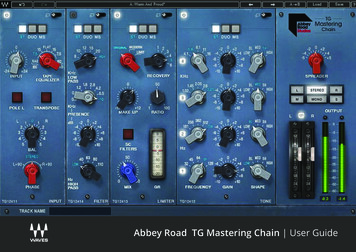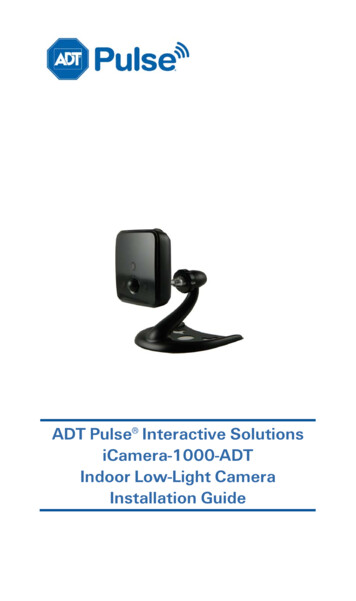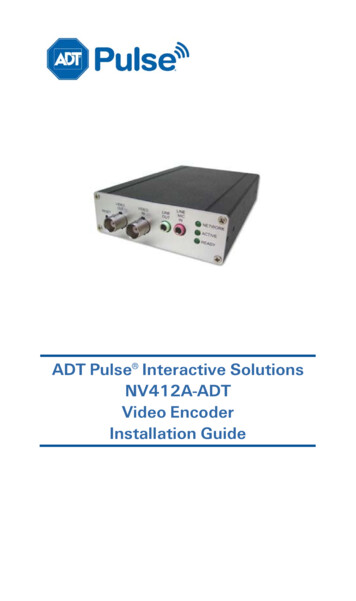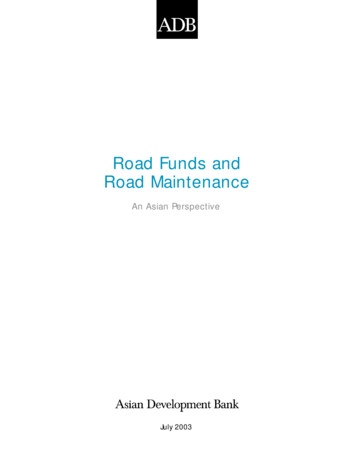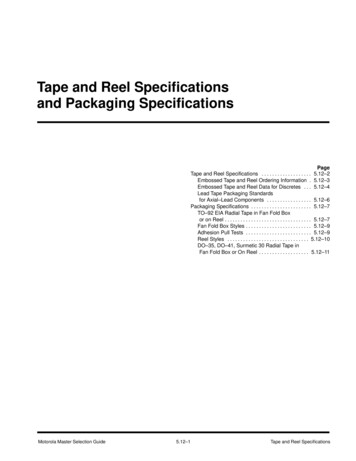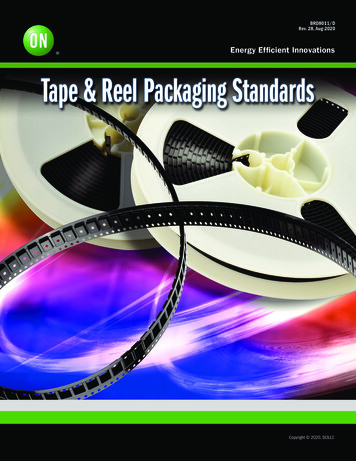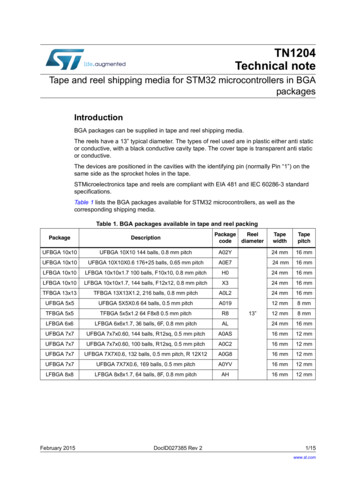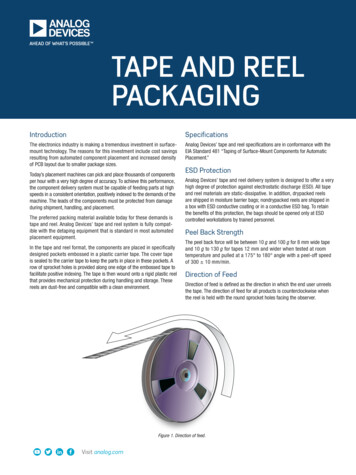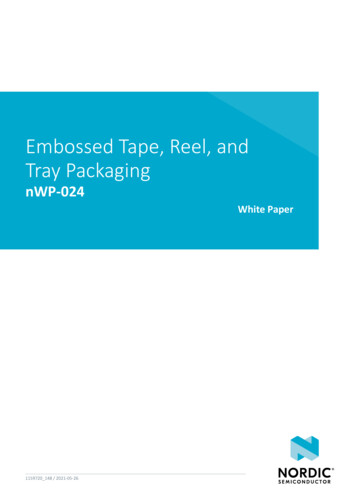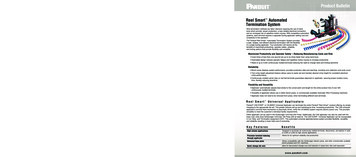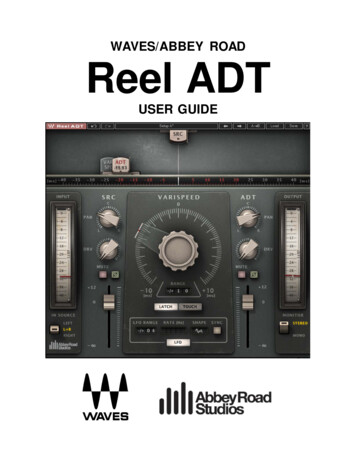
Transcription
WAVES/ABBEY ROADReel ADTUSER GUIDE
TABLE OF CONTENTSChapter 1 – Introduction . 31.1 Welcome. 31.2 Product Overview. 31.3 About ADT. 41.4 Concepts and Terminology . 71.5 Components . 7Chapter 2 – Quick Start (featuring the Mono-to-Stereo Component). 9Chapter 3 – Interface and Controls. 103.1 Interface (featuring the Stereo Component). 103.2 Controls. 11General Controls . 11Varispeed Section . 11LFO Section. 11SRC (Source) Control Section . 12ADT Control Section. 12ADT 2 Control Section (Only in Reel ADT 2V) . 13Chapter 4 – The WaveSystem . 144.1 The WaveSystem Toolbar . 144.2 Preset Handling. 144.3 Interface Controls . 174.4 Waves Preferences (Pro Tools only) . 18Abbey Road Studios and their associated logos are trademarks of EMI (IP) Limited.Waves / Abbey Road ADTUser Guide2
Chapter 1 – Introduction1.1 WelcomeThank you for choosing Waves. To get the most out of your Waves processor, please take thetime to read this manual.We also suggest you become familiar with the resources available to you at waves.com. Thereyou will find an extensive Answer Base, the latest Tech Specs, detailed Installation Guides,new Software Updates, and up-to-date information on Activation and Registration.1.2 Product OverviewWaves: Abbey Road Reel ADT is the first plugin to successfully emulate Abbey Road Studios’pioneering process of Artificial Double Tracking. The effect that became an integral part ofAbbey Road’s signature sound was initially created at the famed studios in the 1960s to meetthe needs of some very special clients: The Beatles.Reel ADT puts the magic of that era in your hands within seconds. Using its intuitive controls,you can advance or push back the doubled signal to achieve genuine, lush-sounding delay andpitch variations. You can also drive each of the signals separately to add beautiful tapesaturations.With its authentic modeled valve tape machine sound and faithful emulation of wow and flutter,this extraordinary plugin can enhance any track with the impression of two separate takes,giving you results as close as possible to real double tracking. Other classic Abbey Road tapeeffects such as flanging and phasing can also be achieved with ease.All the character, depth and panoramic sound of this inimitable classic effect can now becreated digitally, simply and for real: Reel ADT.Waves / Abbey Road ADTUser Guide3
1.3 About ADTADT was invented at Abbey Road Studios in the mid-1960s to produce a double tracking effectwithout the need to record two separate tracks.The Original SetupThe original setup consisted of two tape machines:Source Tape Machine: This was a valve tape machine with a unique feature. Most professionaltape machines had three heads (ERASE, RECORD/SYNC and PLAY) and one output amplifierto switch between the RECORD/SYNC head and the PLAY head, depending on whether themachine was being used for recording/overdubbing (the RECORD/SYNC head) or for mixing(the PLAY head). Abbey Road tape machines, by contrast, had two output amps: one for theRECORD/SYNC head, another for the PLAY head. Using an Abbey Road model, it wastherefore possible to output two instances of the same original signal simultaneously. Due to thephysical gap between the two heads, there would be a slight delay between the two instances.This delay, along with the ability to play both outputs simultaneously, were the vital features thatmade ADT possible. These unique features of Abbey Road’s tape machines may also explainwhy other studios were not able to recreate the Abbey Road ADT effect very convincingly.ADT Tape Machine: This was a second valve tape machine with Varispeed control (a VCO, orvoltage-controlled oscillator, coupled with a powerful amp). The signal from the RECORD/SYNChead of the SOURCE tape machine would feed into this second tape machine. The ADT tapemachine would be in INPUT/RECORD mode, so the signal fed into it would come straight backoff the tape. This would create yet another delay, due to the gap between the RECORD/SYNChead and the PLAY head of the second tape machine.The delays caused by the head gaps in the two machines realigned the two signals, so that theywere nearly simultaneous. The Varispeed could be used to fine-tune the length of delay andeven to advance the effected sound before the source sound.The two resulting signals would then be fed into a mixing console. Different results could beachieved, depending on how the two signals were panned in the stereo field. When both signalswere panned to or near the center, the result would be a distinctive, if not entirely naturalsounding effect (this unnatural sound was, however, part of what made the technique soWaves / Abbey Road ADTUser Guide4
appealing). However, when the signals were panned left and right in the stereo field, the doubletracking effect could sound very convincing indeed. This version of ADT was often used tocreate lush-sounding stereo imaging when using a four-track tape as the source for a stereomixdown.It was common practice to constantly move around the Varispeed of the second tape machine.This was done by hand, using the VCO remote control. Depending on the direction in which theknob was turned and the speed at which this was done, subtle (or, if so desired, very unsubtle)movements could be created between the two sources. This is what made the effect sound soorganic, as even certain words or phrases within a single vocal take could be treated differently.The fact that each of the two tape machines had its own variations of wow and flutter, not tomention a different motor running at a slightly different speed, only enhanced this lush organiceffect.The resulting sound is the most legendary of all Abbey Road tape effects.How ADT Was InventedWhen working on ‘Tomorrow never Knows’, John Lennon complained about the tedious task ofrecording a doubled vocal take—a technique that was widely used in those days to boost andenrich vocal parts. He needed to match the second take as closely as possible to the lead take,which took considerable time and effort on his part. In response, Abbey Road technical engineerKen Townsend came up with ADT. Townsend understood that to achieve a natural-soundingeffect, simply applying a different EQ or compression would not do; worse, it would createphasing problems. What he needed was a process that would alter the timbre, time and pitch ofthe vocal take. He realized that changing the tape speed back and forth would create all thoseeffects simultaneously.The technique he finally came up with worked as follows. When mixing a song, the track to beartificially doubled—usually a vocal track, though any other track could be treated similarly—would be routed from the recording head of the multitrack tape, which was ahead of theplayback head, and fed to the recording head of the second tape machine. An oscillator wouldthen be used to vary the speed of the second machine, providing more or less delay dependingon how quickly or how slowly the second machine was being run in relation to the first. Thissignal would then be routed from the playback head of the second machine to a separate faderWaves / Abbey Road ADTUser Guide5
on the mixer. The tape operator had to ‘ride’ the Varispeed (VCO) control in order to create thedesired effect; any mistake along the way would require another take.The introduction of ADT was a milestone in the history of sound recording, and the techniquewas used heavily on many historic recording sessions at Abbey Road Studios. Over the years,many recording engineers have tried to replicate the effect, but with only partial success, largelybecause a definitive description of the exact process used at Abbey Road has until now been aclosely guarded secret.Other Related EffectsADT led Abbey Road’s engineers to experiment with a number of secondary effects. Two ofthese—flanging and phasing—are possible with the current plugin.Flanging:As noted in the Quick Start section of the present manual, the classic ADT sound is achievedwith about 15 milliseconds of advance or delay between the two signals. When the two signalsare placed closer together, however—between 0 and 5 ms (with the Varispeed controller usedto continuously vary the speed within that range)—the frequencies of the two signals combine tocreate a series of peaks and dips in the audio spectrum. This effect, known as flanging, wasanother firm Beatles favorite at Abbey Road.It is worth noting that flanging almost certainly originated somewhere else, albeit using differentmethods and with slightly different results. Most Abbey Road engineers were not aware ofprevious experimentation with flanging, however, and were under the impression that the effectand its name were invented at Abbey Road.Phasing:Phasing used the same set-up as flanging, but with the signal from the second tape machinephase-reversed by 180 degrees, giving a deeper effect. When the two signals reached the pointof zero delay, their waveforms were at equal strength but at opposite polarity, resulting in almosttotal cancelation. In contrast to flanging, then, which was an addition of signal frequencies,phasing was a subtraction of signal frequencies, creating more of a ‘ducking’ effect.Waves / Abbey Road ADTUser Guide6
1.4 Concepts and TerminologyUnderstanding the following terms will help you achieve the best results using your ADT plugin: SRC (or Source) refers to the unmodulated signal. ADT refers to the effect side of the plugin, i.e. the modulated signal. Display Area refers to the top section of the plugin, where the user can see the overallmodulation of the ADT channel. This includes Varispeed modulation, LFO modulation,and smoothing, the latter a modeling of the physical engine acceleration. Varispeed refers to the control used to vary the speed of the modulated ADT signalmanually. LFO is an automatic way of modulating the ADT signal. It uses a low-frequency oscillatorto ride the signal automatically. 1.5 ComponentsWaveShell technology enables us to split Waves processors into smaller plugins, which we callcomponents. Having a choice of components for a particular processor gives you the flexibilityto choose the configuration best suited to your material. ADT includes the followingcomponents: ADT Mono ADT Mono-to-Stereo ADT Stereo ADT 2V Mono-to-Stereo ADT 2V Stereo ADT Live Mono ADT Live Mono-to-Stereo ADT Live Stereo ADT Live 2V Mono-to-Stereo ADT Live 2V StereoWaves / Abbey Road ADTUser Guide7
ADT 2V adds a second ADT modulation of the signal, allowing you to control each of the twomodulated signals independently in order to generate a richer doubling effect.Please note that both ADT Stereo and ADT 2V Stereo give users the option of either selectingjust one of the input stereo tracks, Left or Right, or summing both stereo tracks to mono(dividing the result by two to maintain perceived loudness).ADT Live components have been added to meet the requirements of live performances byproviding especially low latency for live shows. ADT’s regular (non-live) components rely onlatency to advance the ADT signal relative to the source signal. To minimize latency in a livesetting, the ADT Live components do not offer the option of advancing the ADT signal ahead ofthe source. In ADT Live, the ADT signal can only be delayed relative to the source. To allowpreset sharing between the ADT and ADT Live components, the Live components automaticallytranslate negative ADT values to positive values.Apart from the differences noted above, the ADT Live components are exactly the same as theReel ADT’s regular components.Waves / Abbey Road ADTUser Guide8
Chapter 2 – Quick Start (featuring the Mono-to-StereoComponent) Open the ADT plugin on a vocal track. Grab the ADT control in the display area above the ruler and play around with it until youget a good-sounding static double effect. Recommended ranges are -10 to -15 ms (withthe ADT signal playing in advance of the source) and 10 to 15 ms (with the ADT signalplaying after the source). Experiment with the LFO, preferably on a random shape, and play with the range(recommended range is 3-8 ms) until you get a good doubling effect that does not soundsynthetic or unnatural. Try using the Varispeed control with wide range settings to emphasize word endings orto adjust the effect to your liking. Add some drive to taste. To maximize the doubling effect, adjust the overall level of each channel so that the ADTand SRC channels both have the same apparent loudness. Experiment with the panning between the two signals. You will get a different sound ifthe signals are on top or close to one another, as opposed to panned mid to hard leftand right.Waves / Abbey Road ADTUser Guide9
Chapter 3 – Interface and Controls3.1 Interface (featuring the Stereo Component)Waves / Abbey Road ADTUser Guide10
3.2 ControlsGeneral ControlsADT PositionBounds the Varispeed playing range and determines whether the ADT signal plays before,around, or after the source. To move the ADT position, click on the ADT tape head in thedisplay area.Please Note: In ADT Live, the ADT signal can play only after the source.Input SourceDetermines which of the stereo channels is sent for ADT processing. Click Left to select the leftchannel, Right to select the right channel, and L R to sum both channels to mono, dividing theresult by two to maintain perceived loudness.MonitorLets you monitor the plugin’s output in mono, helping you track the amount of phasingintroduced by the process.Varispeed SectionVarispeedControls the time movement of the ADT. Varispeed has the same function as the voltagecontrolled oscillator used in the original ADT setup to shift the speed (and hence time) of thedoubled track. The Varispeed range is variable to give the best resolution and control over thedesired movement.Range: Variable between -/ 20 ms and -/ 1 ms, in 1 ms increments.Please note: For ease of use, the Varispeed control can be assigned to MIDI. Check your DAWto find how to assign MIDI controls.Varispeed ModeDetermines Varispeed's working mode:Latch: When you rotate the Varispeed control and then release it, the control stays on thereleased value.Touch: When you rotate the Varispeed control and then release it, the control jumps back to 0.LFO SectionLFO On/OffTurns the LFO on or off. The LFO will automatically modulate the delay time of the Varispeed.LFO RangeSets upper and lower limits for the LFO cycle. E.g., select 3 to limit the LFO cycle to -/ 3 ms.Range: Variable between -/ 20 ms and -/ 1 ms, in 1 ms increments.Waves / Abbey Road ADTUser Guide11
LFO ShapeDetermines the shape of the LFO cycle: sine, triangular, reverse sine, reverse triangular, orrandom.LFO Rate (Hz)Sets the rate at which the LFO completes the range selected in the LFO Range control.LFO Rate (Bars) (only when LFO Sync mode is on)Sets the rate at which the LFO completes the range selected in the LFO Range control, only interms of bars rather than Hz. For example, when the selected range is -/ 3, LFO Sync is on; ifthe user selects 6 bars, the LFO will take 6 bars to complete a full cycle of -/ 3 ms.Range: ¼, ½, 1, 1½, 2, 2½, 3, 3½, 4, 6, 8, 9, 12, 16LFO SyncWhen Sync is on, the LFO rate is set automatically by calculating the session’s tempo,measure, and resolution and the selected Rate (Bars) setting. For example, the user can set theLFO Rate to 4 bars, and the plugin will calculate the actual rate needed to make this happen.SRC (Source) Control SectionSRC PanControls the position of the source signal in the stereo image.Range: 100L–100RSRC DriveControls the amount of tape saturation.Range: 0–30SRC MuteMutes the source signal in the output.SRC PhaseInverts the phase of the source signal (see ADT phase below).SRC LevelControls the level of the source signal.Range: 12 to -Inf dB (continuous control, 0.1 dB resolution)Please note: The ADT output is normalized in order to maintain constant gain when the ADTand SRC channels are panned hard left and hard right.ADT Control SectionADT PanControls the position of the ADT signal in the stereo image.Range: 100L–100RWaves / Abbey Road ADTUser Guide12
ADT DriveControls the amount of tape saturation.Range: 0–30ADT MuteMutes the ADT signal in the output.ADT PhaseInverts the phase of the ADT signal. Use this to create a Phasing effect when the two signalsare very close to one another (between 0 and 5 ms).ADT LevelControls the level of the ADT signal.Range: 12 to -Inf dB (continuous control, 0.1 dB resolution)Please note: The ADT output is normalized in order to maintain constant gain when the ADTand SRC channels are panned hard left and hard right.ADT 2 Control Section (Only in Reel ADT 2V)ADT 2 PanControls the position of the ADT signal in the stereo image.Range: 100L–100RADT 2 DriveControls the amount of tape saturation.Range: 0–30ADT 2 MuteMutes the ADT signal in the output.ADT2 PhaseInverts the phase of the ADT 2 signal.ADT 2 LevelControls the level of the ADT signal.Range: 12 to -Inf dB (continuous control, 0.1 dB resolution)Please note: The ADT output is normalized in order to maintain constant gain when the ADTand SRC channels are panned hard left and hard right.Waves / Abbey Road ADTUser Guide13
Chapter 4 – The WaveSystem4.1 The WaveSystem ToolbarAll Waves plugins feature the WaveSystem toolbar, which takes care of most administrativefunctions you will encounter while working with your Waves software. The features of theWaveSystem toolbar are the same on practically all Waves plugins, so familiarity with itsfeatures will be helpful with whichever plugin you are using.Toolbar FunctionsOpens the plugin About boxUndoUndoes the last action (up to 32 actions)RedoRedoes the last action (up to 32 undone actions)Setup A/BToggles between two presets, useful for comparison of parameter settingsL/R ArrowsMove to the previous or next presetCopy A BCopies the current settings to the second preset registerLoadR
ADT led Abbey Road’s engineers to experiment with a number of secondary effects. Two of these—flanging and phasing—are possible with the current plugin. Flanging: As noted in the Quick Start section of the present manual, the classic ADT sound is achieved with about 15 m
